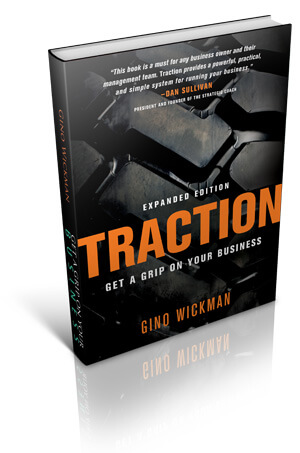The theme on Spin Sucks this month is planning (Lindsay Bell has more on that for you tomorrow afternoon) and I could not be more excited!
I could actually write every, single day on this topic (I won’t, in favor of letting other voices have a say) because it is one of my most favorite things to do.
I love to brainstorm with my team, think through challenges, and find solutions that are going to help our client’s organizations grow.
And, for the first time in the history of Arment Dietrich, I have a nearly complete leadership team so planning has been way more fun this year.
(They may not think so, but I do!)
Though it’s been a very long process (I think we’re on week five), the planning has reinvigorated my team and they’re all as excited as I am for what 2015 brings (they probably don’t fully realize how hard they’re going to have to work to achieve what we’ve put on paper).
Traction: Get a Grip On Your Business
Because the business has been run, well, uh, very entrepreneurially for the past nine years, we’ve never done the planning necessary to scale a business.
A couple of months ago, I was talking to a friend about how I was struggling to scale the business, and he said, “Read Traction. Promise me you’ll read it.”
I bought it on my way home from that business trip and read nearly all of it on the flight.
Boy did he nail that one right on the head (I’ve since recommended it to three other entrepreneurs, though it feels like a secret I should keep to myself).
It pretty much started out by saying most entrepreneurs hit a wall, when it comes to growth, because they’re accustomed to growing through referrals and taking any prospect that comes along.
(Uh, yeah.)
Then it goes on to say the business probably demanded that you fly by the seat of your pants.
(Uh, yeah.)
This involved reacting to every client request, thinking on your toes, and being creative on the fly.
(Yep again.)
Then it shames you for thinking you can scale a business away (I have Mormon guilt; I can’t help it!) and talks about the importance of processes, if you want to scale.
Now, I know processes are important. It’s something I hear over and over again. But (and I shouldn’t admit this out loud), everything is in my head, which means *I* have to take a lot of time to get them out of my head and onto paper.
And when you’re reacting to every client request, thinking on your toes, being creative on the fly, writing books, traveling the world speaking, and tweeting, you don’t have time to get them out of your head.
Stop the Presses!
As soon as I made that very excuse to myself, I knew something had to change.
It was time to focus on planning, but not planning for planning sakes.
We had to do planning that would make it easy to execute and work toward our big, hairy audacious goals.
We had to do planning that would stick and allow us to focus so we can scale this business.
There are eight questions the book requires you think through, plan for, and work with your leadership team (even if you leadership team is just you and the dog) to get onto paper.
- What are your core values?
- What is your core focus?
- What is your 10-year target?
- What is your marketing strategy?
- What is your three-year picture?
- What is your one-year plan?
- What are your quarterly rocks?
- What are your issues?
Super easy questions to answer, right?
Ha!
But we took each one (sometimes two) every week during our leadership team meeting and started to dig into how each of us would answer them.
It’s been fun, it’s been interesting, and it’s been uncomfortable.
Every, single person on my team brings a different perspective and different expertise, so it’s been fun debating the merits of what the others think to come to something we can all agree on.
Planning Takes Discipline
Though the draft document throughout the planning process is about 30 pages, we’re narrowing it down to only two pages.
On page one are our five core values, our purpose, our niche, the three things that make us unique, our process, and our three-year plan.
On page two are our one-year plan, our quarterly rocks, and any issues we need to address that could prevent us from achieving our very lofty goals.
When we are finished (the goal is November 21), we will know exactly what each of us has to do to beat our goals next year.
The idea here is to not write a plan so large, you never go back to it. The idea is to drill it down into something that can sit on your desk for referral daily. I actually have a screen grab of it and it’s my computer desktop screen saver.
You want to work against it every day and you can’t do that if it’s 30 pages.
Who knows if it’ll actually work. The real test is in our execution. But I hope I’m able to write a blog post a year from now about how we scaled this business and beat our goals, and what we learned during the process.
